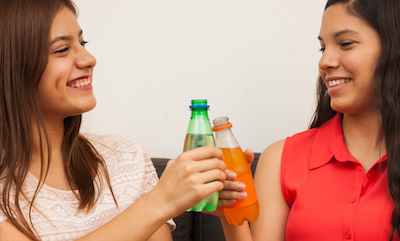Home Plays Bigger Role Than Neighborhood or School in Teens’ Sugary Drink Consumption.
 How many sugary beverages an adolescent consumes is influenced far more by the availability of these drinks at home than at school or in the neighborhood, according to a new study co-authored by a School of Public Health researcher.
How many sugary beverages an adolescent consumes is influenced far more by the availability of these drinks at home than at school or in the neighborhood, according to a new study co-authored by a School of Public Health researcher.
The study, published in The Journal of Pediatrics, found teens who often or always had sugar-sweetened beverages available at home were about 5.6 times more likely to be heavy daily consumers of sugar-sweetened beverages than peers who never had sugary drinks available at home, regardless of the availability of sugar-sweetened beverages in their schools or school neighborhoods.
“Parents still play a major role in shaping their children’s diet through the food and drinks made available at home, even though adolescents spend substantial time in other settings,” says study co-author Monica Wang, assistant professor of community health sciences. “That can be a very empowering opportunity for parents to improve their children’s diet through small changes.”
The researchers used data on 1,494 participants from the 2014 Family Life, Activity, Sun, Health, and Eating (FLASHE) study of adolescents between the ages of 12 and 17 years old. For the new study, the researchers looked at sugar-sweetened beverage availability in the home, categorized as “never,” “rarely/sometimes,” or “often/always,” and whether adolescents reported non-daily sugar-sweetened beverage consumption, daily consumption of fewer than two sugar-sweetened beverages, or heavy daily consumption of two or more sugar-sweetened beverages.
The researchers also looked at whether adolescents reported their schools having vending machines with “sodas, salty snacks, and/or candy,” and whether adolescents reported at least one convenience store, corner store, small grocery store, bodega, supermarket/midsize grocery store, fast food restaurant, or non-fast food restaurant within a 10-15-minute walk from school. The researchers adjusted for adolescents’ age, sex, race, body mass index, and their parents’ marital status and housing insecurity.
About one-third (32.6 percent) of the adolescents were nondaily consumers of sugar-sweetened beverages, while 33.9 percent consumed at least one but fewer than two per day, and 33.5 consumed two or more per day.
Almost half (44.4 percent) reported that sugar-sweetened beverages were often or always available at home. Adolescents who said sugar-sweetened beverages were often/always available at home were 5.5 times more likely to report heavy daily consumption than their peers who never had it at home. Adolescents who rarely/sometimes had sugar-sweetened beverages available at home were about three times more likely to report heavy daily consumption than their peers who never had it at home.
Looking at when sugar-sweetened beverages were or were not available at school or in school neighborhoods, the researchers continued to find similar associations: adolescents who often/always had sugary drinks available at home were between five and six times more likely to be heavy daily consumers than their peers who did not have sugary drinks at home, and those who rarely/sometimes had them at home were still about three times more likely to be heavy daily consumers than their peers who did not have sugary drinks at home.
“More than one-half of adolescents’ calories are consumed at home, and findings from this study emphasize that the home does matter,” the authors wrote. “Parents can be empowered to make small changes in the home to reduce sugar-sweetened beverage availability and promote healthier diets for their adolescents.”
The study was led by Christina Haughton of the University of Massachusetts Medical School. The other co-authors were Molly Waring of the University of Connecticut and of the University of Massachusetts Medical School, and Milagros Rosal, Lori Pbert, and Stephanie Lemon of the University of Massachusetts Medical School.